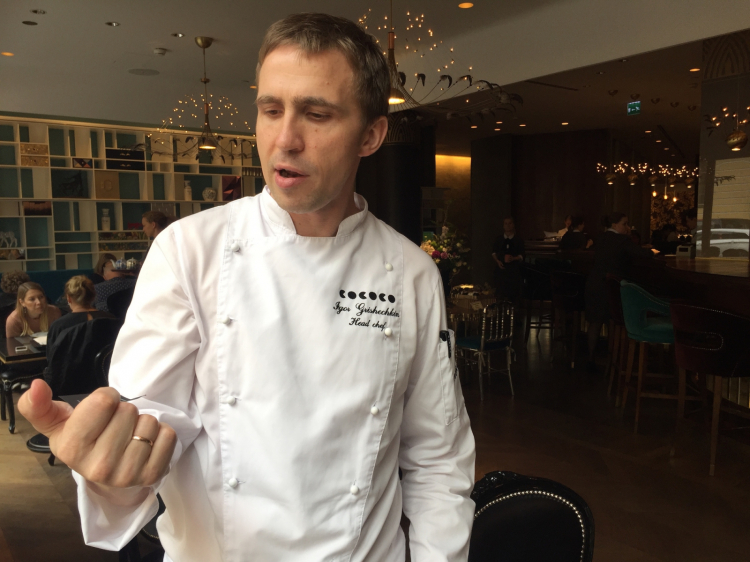Having completed the overview of the best restaurants in Saint Petersburg, let’s see how and what the most interesting chef in town cooks. His name is Igor Grishechkin, he is 35 and comes from Smolensk, a sleepy town some 750 km to the south, on the banks of river Dnepr, on the border with Byelorussia.
Like many twenty year olds ignited by the sacred fire of cooking, he soon moves to Moscow. In the capital, he trains at the two dominating restaurants, then and now: Italian Casta Diva and French Ragout, the first gastro-bistro in town. Four years ago, the turning point in Saint Petersburg where he immediately takes on the helm of the elegant Kokoko, an appendix of the W hotel on Voznesensky, a calm intersection with Nevskij Prospekt, the famous street that cuts the centre of Saint Petersburg in half (the one where Franco Battiato met Igor Stravinskij by chance).
Conceiving creative or “fine dining” cuisine in a country that fell into a 70-year-long gastronomic lethargy is no easy task. Older generations are especially diffident of what for many years were foreign ingredients and the habit of eating out is still not popular: it’s still a special occasion. People go to the restaurant as often as they go to the theatre or to a concert. Not more than once a month. If anything, they go out to drink.

Igor Grishechkin, 35, from Murmansk
Yet Russian Millennials are slowly clearing the ground from Soviet habits. It is them whom
Igor addresses on Thursdays, the only day in the week when he shows off a creative menu for 5000 roubles (aound 70 euros), which the rest of the week is surpassed by the more reassuring borscht, grilled sturgeon and crème brûlée.
«The chefs I admire are
René Redzepi,
Magnus Nilsson and
Massimo Bottura», he says hiding behind a veil of shyness. This is confirmed by some rustic dishes with a Great North plating (hay, shreds of forests, river stones) and a sense of playfulness that is the real fil rouge of the 12 steps in the menu, from the welcome egg with meringue (
Kokoko is the universal sound of hens), served in egg packaging, to the gelatinous lollypop among the petit fours. It’s in the shape of a rooster, pierced with a stick and powdered with popping fragments [like Fizz Wizz popping candy].
While the technical approach recalls an echo of the most contemporary Europe – and this had to be the case – the content is 100% Russian. Indeed the young man studies Czarist traditions until late, both the edible pre-revolution ones and the other symbols that defined the cultural identity.
The White chocolate Fabergé egg with caviar and gold recalls the famous Easter jewel that Alexander III would give to the queen each year. Kasha isz topora recalls the ancient legend of the Stone soup, in which a man armed with an axe (which in this case is made of butter and squid ink that melts in the bowl) cooks flying porridge; rye bread recalls the bloody Battle of Borodino in 1812; the wax ice cream cake is a tribute to bees, the most venerated insect from Saint Petersburg to Vladivostok.
And who cares if they serve porcini soup in July: «In the autumn and winter», says Grishechkin, «I must make a virtue out of necessity because earth freezes and there’s very little left to eat». Hence all the tricks that are typical among northern people, who when the right season comes, dehydrate, marinate and pickle. The sour notes are rather strong (cucumbers, dill, sour cream) and the chef balances them with an Adrianesque work on textures (salmon ice cream, fennel gelatine, a granita made with plum compote) which in the end add a nice overall roundness.
The short wine list is also interesting. It’s designed by Yulia Khaybullina, sommelière at Moroshka for Puskin: aside from owing to Old Europe (with Champagne and Barolo above all), it has a page illustrating the great wine potential of the area around Sebastopol, in controversial Crimea. «The calcareous soil is just like the one in Bourgogne», she says. Too bad they plant international grape varieties such as Riesling, Chardonnay and even Barbera and few local grapes like Sibirkovy, Sary Pandas or Krasnostop, which should deserve deeper explorations.
Exactly like the endless country, a basin of such varied climates and soils that it’s hard to imagine its potential. Possibly the longest zero kilometre in the world.
See also
Saint Petersburg’s comeback
Russian potential: the pavilion at Expo
The new Russian cuisine/1
The new Russian cuisine/2
The new Russian cuisine/3